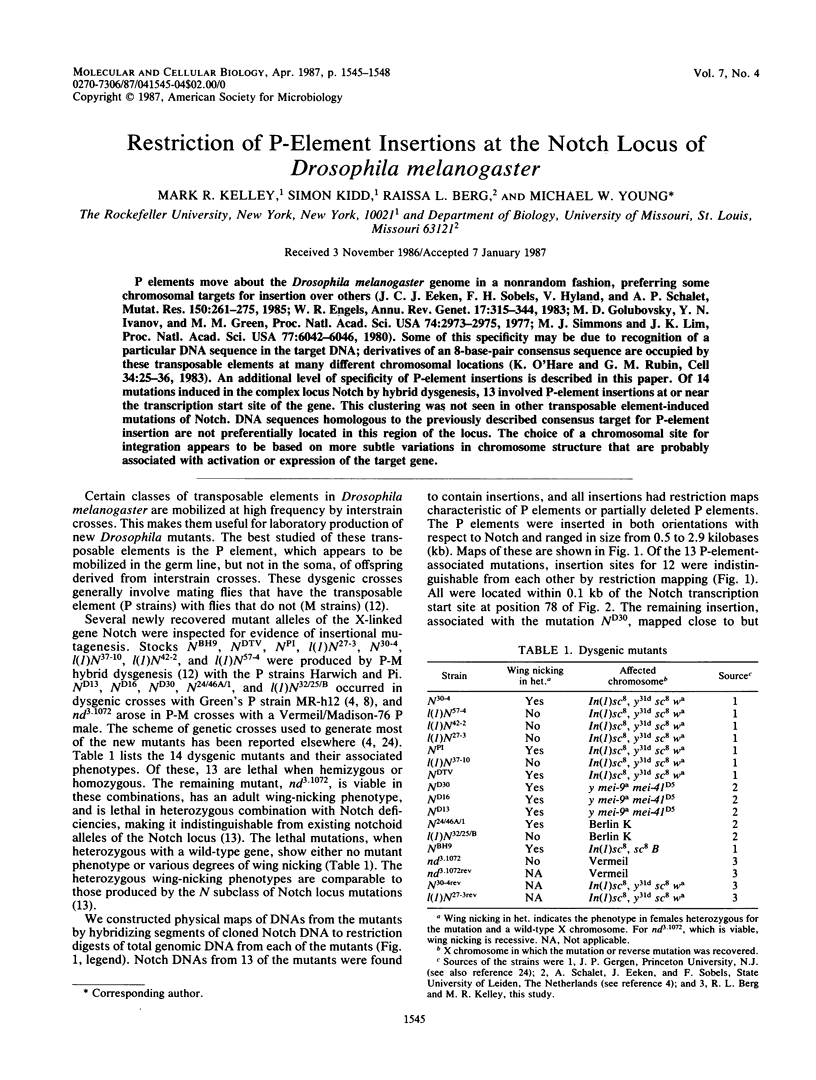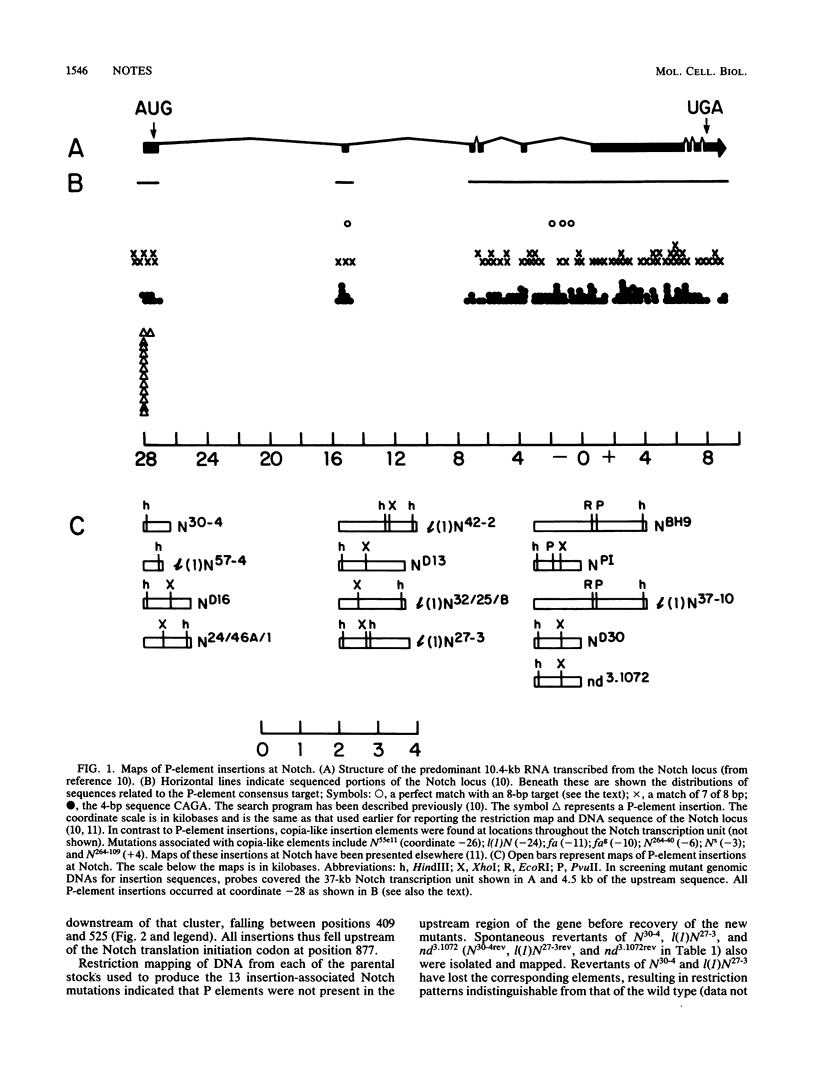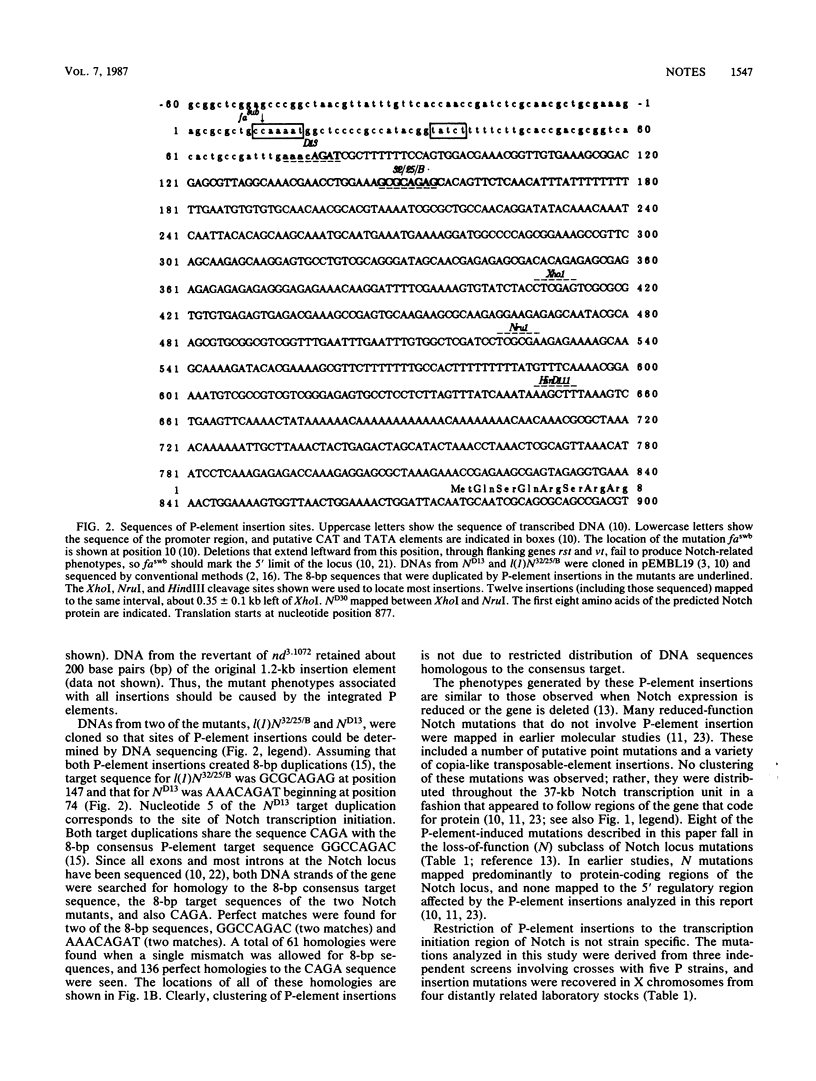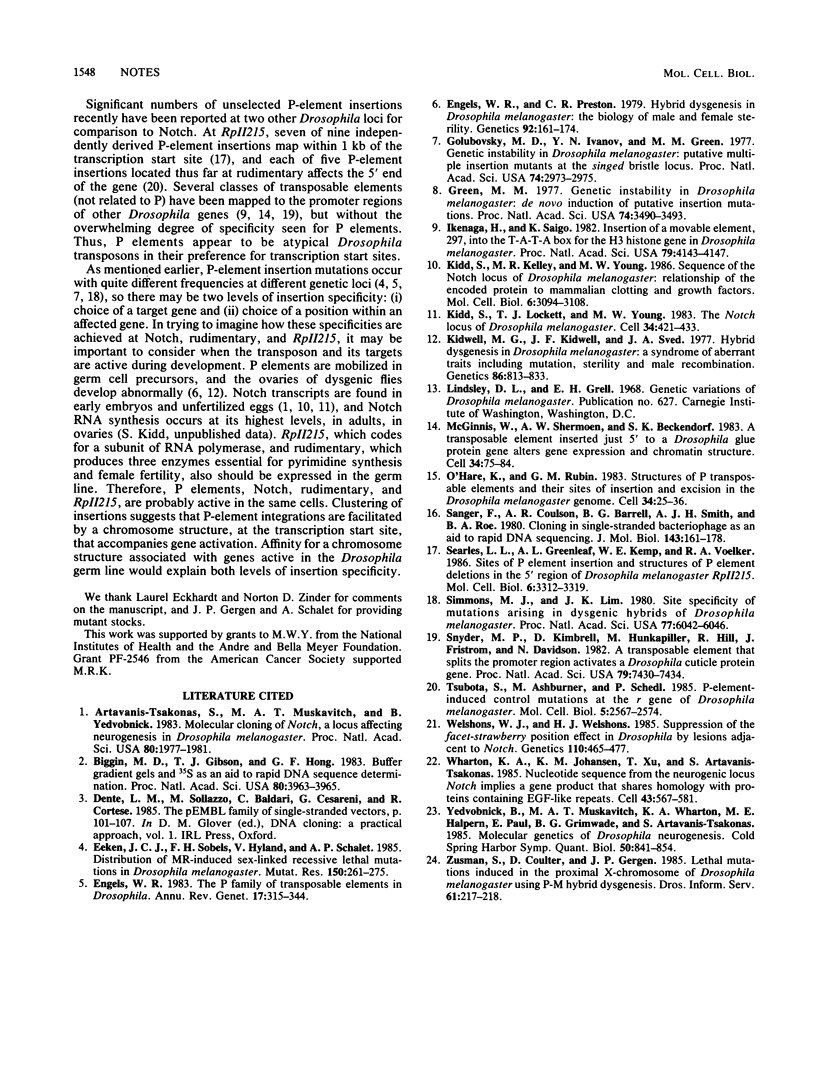Abstract
P elements move about the Drosophila melanogaster genome in a nonrandom fashion, preferring some chromosomal targets for insertion over others (J. C. J. Eeken, F. H. Sobels, V. Hyland, and A. P. Schalet, Mutat. Res. 150:261-275, 1985; W. R. Engels, Annu. Rev. Genet. 17:315-344, 1983; M. D. Golubovsky, Y. N. Ivanov, and M. M. Green, Proc. Natl. Acad. Sci. USA 74:2973-2975, 1977; M. J. Simmons and J. K. Lim, Proc. Natl. Acad. Sci. USA 77:6042-6046, 1980). Some of this specificity may be due to recognition of a particular DNA sequence in the target DNA; derivatives of an 8-base-pair consensus sequence are occupied by these transposable elements at many different chromosomal locations (K. O'Hare and G. M. Rubin, Cell 34:25-36, 1983). An additional level of specificity of P-element insertions is described in this paper. Of 14 mutations induced in the complex locus Notch by hybrid dysgenesis, 13 involved P-element insertions at or near the transcription start site of the gene. This clustering was not seen in other transposable element-induced mutations of Notch. DNA sequences homologous to the previously described consensus target for P-element insertion are not preferentially located in this region of the locus. The choice of a chromosomal site for integration appears to be based on more subtle variations in chromosome structure that are probably associated with activation or expression of the target gene.
Full text
PDF



Selected References
These references are in PubMed. This may not be the complete list of references from this article.
- Artavanis-Tsakonas S., Muskavitch M. A., Yedvobnick B. Molecular cloning of Notch, a locus affecting neurogenesis in Drosophila melanogaster. Proc Natl Acad Sci U S A. 1983 Apr;80(7):1977–1981. doi: 10.1073/pnas.80.7.1977. [DOI] [PMC free article] [PubMed] [Google Scholar]
- Biggin M. D., Gibson T. J., Hong G. F. Buffer gradient gels and 35S label as an aid to rapid DNA sequence determination. Proc Natl Acad Sci U S A. 1983 Jul;80(13):3963–3965. doi: 10.1073/pnas.80.13.3963. [DOI] [PMC free article] [PubMed] [Google Scholar]
- Eeken J. C., Sobels F. H., Hyland V., Schalet A. P. Distribution of MR-induced sex-linked recessive lethal mutations in Drosophila melanogaster. Mutat Res. 1985 Jun-Jul;150(1-2):261–275. doi: 10.1016/0027-5107(85)90122-8. [DOI] [PubMed] [Google Scholar]
- Engels W. R., Preston C. R. Hybrid dysgenesis in Drosophila melanogaster: the biology of female and male sterility. Genetics. 1979 May;92(1):161–174. doi: 10.1093/genetics/92.1.161. [DOI] [PMC free article] [PubMed] [Google Scholar]
- Engels W. R. The P family of transposable elements in Drosophila. Annu Rev Genet. 1983;17:315–344. doi: 10.1146/annurev.ge.17.120183.001531. [DOI] [PubMed] [Google Scholar]
- Golubovsky M. D., Ivano Y. N., Green M. M. Genetic instability in Drosophila melanogaster: putative multiple insertion mutants at the singed bristle locus. Proc Natl Acad Sci U S A. 1977 Jul;74(7):2973–2975. doi: 10.1073/pnas.74.7.2973. [DOI] [PMC free article] [PubMed] [Google Scholar]
- Green M. M. Genetic instability in Drosophila melanogaster: De novo induction of putative insertion mutations. Proc Natl Acad Sci U S A. 1977 Aug;74(8):3490–3493. doi: 10.1073/pnas.74.8.3490. [DOI] [PMC free article] [PubMed] [Google Scholar]
- Ikenaga H., Saigo K. Insertion of a movable genetic element, 297, into the T-A-T-A box for the H3 histone gene in Drosophila melanogaster. Proc Natl Acad Sci U S A. 1982 Jul;79(13):4143–4147. doi: 10.1073/pnas.79.13.4143. [DOI] [PMC free article] [PubMed] [Google Scholar]
- Kidd S., Kelley M. R., Young M. W. Sequence of the notch locus of Drosophila melanogaster: relationship of the encoded protein to mammalian clotting and growth factors. Mol Cell Biol. 1986 Sep;6(9):3094–3108. doi: 10.1128/mcb.6.9.3094. [DOI] [PMC free article] [PubMed] [Google Scholar]
- Kidd S., Lockett T. J., Young M. W. The Notch locus of Drosophila melanogaster. Cell. 1983 Sep;34(2):421–433. doi: 10.1016/0092-8674(83)90376-8. [DOI] [PubMed] [Google Scholar]
- Kidwell M. G., Kidwell J. F., Sved J. A. Hybrid Dysgenesis in DROSOPHILA MELANOGASTER: A Syndrome of Aberrant Traits Including Mutation, Sterility and Male Recombination. Genetics. 1977 Aug;86(4):813–833. doi: 10.1093/genetics/86.4.813. [DOI] [PMC free article] [PubMed] [Google Scholar]
- McGinnis W., Shermoen A. W., Beckendorf S. K. A transposable element inserted just 5' to a Drosophila glue protein gene alters gene expression and chromatin structure. Cell. 1983 Aug;34(1):75–84. doi: 10.1016/0092-8674(83)90137-x. [DOI] [PubMed] [Google Scholar]
- O'Hare K., Rubin G. M. Structures of P transposable elements and their sites of insertion and excision in the Drosophila melanogaster genome. Cell. 1983 Aug;34(1):25–35. doi: 10.1016/0092-8674(83)90133-2. [DOI] [PubMed] [Google Scholar]
- Sanger F., Coulson A. R., Barrell B. G., Smith A. J., Roe B. A. Cloning in single-stranded bacteriophage as an aid to rapid DNA sequencing. J Mol Biol. 1980 Oct 25;143(2):161–178. doi: 10.1016/0022-2836(80)90196-5. [DOI] [PubMed] [Google Scholar]
- Searles L. L., Greenleaf A. L., Kemp W. E., Voelker R. A. Sites of P element insertion and structures of P element deletions in the 5' region of Drosophila melanogaster RpII215. Mol Cell Biol. 1986 Oct;6(10):3312–3319. doi: 10.1128/mcb.6.10.3312. [DOI] [PMC free article] [PubMed] [Google Scholar]
- Simmons M. J., Lim J. K. Site specificity of mutations arising in dysgenic hybrids of Drosophila melanogaster. Proc Natl Acad Sci U S A. 1980 Oct;77(10):6042–6046. doi: 10.1073/pnas.77.10.6042. [DOI] [PMC free article] [PubMed] [Google Scholar]
- Snyder M. P., Kimbrell D., Hunkapiller M., Hill R., Fristrom J., Davidson N. A transposable element that splits the promoter region inactivates a Drosophila cuticle protein gene. Proc Natl Acad Sci U S A. 1982 Dec;79(23):7430–7434. doi: 10.1073/pnas.79.23.7430. [DOI] [PMC free article] [PubMed] [Google Scholar]
- Tsubota S., Ashburner M., Schedl P. P-element-induced control mutations at the r gene of Drosophila melanogaster. Mol Cell Biol. 1985 Oct;5(10):2567–2574. doi: 10.1128/mcb.5.10.2567. [DOI] [PMC free article] [PubMed] [Google Scholar]
- Welshons W. J., Welshons H. J. Suppression of the facet-strawberry position effect in Drosophila by lesions adjacent to notch. Genetics. 1985 Jul;110(3):465–477. doi: 10.1093/genetics/110.3.465. [DOI] [PMC free article] [PubMed] [Google Scholar]
- Wharton K. A., Johansen K. M., Xu T., Artavanis-Tsakonas S. Nucleotide sequence from the neurogenic locus notch implies a gene product that shares homology with proteins containing EGF-like repeats. Cell. 1985 Dec;43(3 Pt 2):567–581. doi: 10.1016/0092-8674(85)90229-6. [DOI] [PubMed] [Google Scholar]
- Yedvobnick B., Muskavitch M. A., Wharton K. A., Halpern M. E., Paul E., Grimwade B. G., Artavanis-Tsakonas S. Molecular genetics of Drosophila neurogenesis. Cold Spring Harb Symp Quant Biol. 1985;50:841–854. doi: 10.1101/sqb.1985.050.01.102. [DOI] [PubMed] [Google Scholar]


